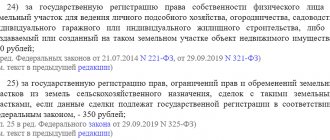On April 26, the Supreme Court of the Russian Federation published a review of judicial practice in cases of establishing an easement on a land plot. We will share the main findings.
You will find out which court to apply to establish, change the conditions or terminate the easement. We will explain what to do if the Unified State Register of Real Estate does not contain information about part of the land plot encumbered by an easement.
Formation of a land plot under a blocked building
What is an easement and how to get one
We have already told you that an easement is the right to limited use of someone else’s real estate (Article 1 N 122-FZ). This right is transferred to another person by right of encumbrance.
The right of encumbrance is otherwise called the right of limitation. Its definition is given in paragraph 1 of Article 1 of the Law on State Registration of Rights. The law or authorized bodies establish restrictions for the land owner in the exercise of ownership or other proprietary rights to a land plot.
Residents of neighboring houses may need an easement in order to lay communications through someone else’s land and use them. An easement may exist independently of the use of the land plot.
If you have received an easement, this does not mean that the plot has passed into your possession and its owners have lost the right to use it (Clause 2 of Article 274 of the Civil Code of the Russian Federation). The owners continue to use it, but for a specific purpose, which is established by contract or agreement.
To obtain an easement, you need to obtain the consent of the owners of the apartment complex. A simple majority of votes at the OCC will be sufficient. After this, an agreement or contract is concluded. This document is included in the technical documentation of the MKD.
Read more about what an easement is and how to get one
Owner rights
For the servitude, the rights are specified in the encumbrance agreement . These include the following:
- The right to use someone else's land within the framework of the possibilities specified in the contract.
- When the owner of a plot changes, the holder of the restriction retains the right to preserve it (Article 275 of the Civil Code).
- The right to demand from the owner the provision of that part of the land on which the encumbrance has been established.
- If it is necessary to extend the period, the owner of the restriction has the right to re-apply for the establishment of an easement.
The owner of the easement does not have the right to force the owner of the land to perform any work or services in his own interests.
Which court considers easement issues?
To accurately determine which court to contact to resolve issues of easement, clarify the subject composition of the parties to the dispute and the nature of the legal relationship. There are two options - a court of general jurisdiction or an arbitration court.
According to Parts 1 and 2 of Art. 27 of the Arbitration Procedure Code of the Russian Federation, arbitration courts consider:
- economic disputes;
- cases involving legal entities and individuals carrying out entrepreneurial activities
- activities without forming a legal entity and having the status of individual entrepreneurs;
- cases involving the Russian Federation, constituent entities of the Russian Federation, municipalities, government bodies, etc.
Courts of general jurisdiction deal with cases provided for in Parts 1 and 2 of Art. 22 Code of Civil Procedure of the Russian Federation. But economic disputes and cases dealt with by arbitration courts are not resolved.
An easement is requested in relation to real estate that can be used for business activities:
- if the parties to the dispute have the status of entrepreneurs,
- if the dispute is between individual entrepreneurs regarding land not used for business activities.
But this fact does not mean that the dispute is of an economic nature and should be considered by an arbitration court.
The Supreme Court cites the district court's ruling as an example. He terminated the proceedings on the claim for the establishment of an easement. The plaintiff had the status of an individual entrepreneur and asked to establish an easement in relation to the land. He needed the easement to provide access to his land plot and non-residential premises.
The district court found that the plaintiff was the owner of a commercial property. His interest is to ensure the passage of transport for the transport of goods. The dispute was of an economic nature and therefore had to be considered by an arbitration court.
But courts of general jurisdiction do not always have the authority to resolve such disputes. For example, a dispute over the cancellation of an easement can be considered by a court of general jurisdiction and an arbitration court. It all depends on which court established the easement.
Registration of a land plot into the common property of the MKD
Responsibilities of a person with a limited right to use someone else's land plot
When concluding an agreement, the person holding the easement is assigned certain obligations , which he must strictly fulfill:
- Do not change the purpose of the land. Make the restriction of use rights for the owner as less burdensome as possible in accordance with clause 5 of Article 23 of the Land Code.
- Carry out cadastral work at your own expense to add restricted zones to the territory.
- Register the agreement with government agencies and pay all costs associated with its registration.
- Do not allow waste to be stored on the territory, maintain a sanitary and environmental situation, and also comply with fire safety measures.
- Compensate for all expenses of the land owner that were associated with the establishment of the encumbrance, no later than a certain period after their occurrence.
- Pay a fee for the use of the site in the amount established. This obligation is spelled out in any contract drawn up and in Article 39.25, clause 1.8 of the Land Code. If payment deadlines are not met, this party to the agreement is subject to penalties, which are measured as a percentage of the amount for use.
- Carrying out work on the site at the end of the period to bring it to a form suitable for use (Article 39.25, clause 1.9 of the Land Code). Also, the owner of the restriction registers and pays for an agreement to cancel the restriction on the site (in which cases the encumbrance of an easement is terminated, we described here).
Grounds for the creation of an easement
The reasons and cases of application of easements to land plots are listed in Article 23 of the Land Code.
An encumbrance in the form of a public easement is used:
- to provide passage/passage through a piece of land if another route cannot be provided, for example, to the shoreline and a public reservoir;
- when part of the site is used for driving farm animals, making hay, or grazing animals at a certain time;
- for drainage work;
- when operating the allotment as a hunting and fishing zone;
- for repair of communications and use of this site;
- when the site is used for the purposes of research and survey work for a certain period.
An easement on a part of the land is required in order to provide other persons with the right to exploit someone else’s land when no other way exists. That is, this type of encumbrance can only be registered by a person whose rights cannot be realized without using someone else’s allotment. An easement is imposed by mutual agreement or forced by a court decision.
A private encumbrance can only be established to fulfill personal needs. For example, a citizen owns a plot of land where there is a natural water source. The owners of neighboring territories have the right to ask or demand permission to pass through the territory of private land to a source to collect water.
Duration of private easement
The validity period of encumbrances is determined by the citizens themselves and the court when it is involved in the issue of assigning an easement. It directly depends on the reasons for the appointment and the need for the encumbrance.
The duration of a private easement for the use of a land plot can be very short, for example, in accordance with the timing of construction work. When using a site for hiking or driving in the absence of other paths, it is advisable to establish an easement for a longer period of time.
Who can be the owner?
Article 5 of the Land Code of the Russian Federation establishes that the holders of an easement are persons to whom, on the basis of an agreement concluded between the parties, a limited right to use other people’s plots of land is transferred.
The encumbrance can be either private or public. Its form is determined based on who is the initiator of setting the restriction.
In the case where the servitude is an individual or organization pursuing its own interests, a private easement is established. Its main feature is remuneration, and the purpose of installation in most cases is to satisfy domestic needs.
A public easement is established in cases where it is required by the state. Its purpose is to ensure the possibility of carrying out economic work necessary for the population or municipality.
We talked in more detail about the difference between private and public easements here.
Attention! A public easement can be introduced without the consent of the land owner on the basis of regulatory documents.
You can find more information about the nuances and rules for establishing public easements here.
Once the restriction is set, the owner receives a corresponding notification. As a rule, a public easement does not involve the transfer of payment to the owner. The only exceptions can be those situations when the imposed restrictions lead to significant difficulties for the owner of the plot. In such situations, the owner has the right to expect compensation from the owner of the easement.
A change of owner does not affect the agreement; the easement remains the same until the end of the contract.
When may court assistance be needed?
You can go to court for an easement at any time. The court is obliged to consider all claims of citizens. However, the judge will be interested in the fact that the plaintiff has attempted to enter into a voluntary agreement with a neighbor. Therefore, if you need to organize an easement on a neighboring plot, you need to try to come to a consensus in the world order.
If there is a conflict of interests, the resolution of the problematic issue is entrusted to the judicial system. When going to court, it is necessary to correctly draw up a statement of claim (under Article 125 of the APC and 131 of the Code of Civil Procedure).
An important point in the claim is the justification for applying for an easement. It is necessary to provide strong evidence (primarily documentary). The plaintiff independently offers a certain fee for the use of the site, the duration of the encumbrance, and other conditions. Documentary attachments must comply with Art. 126 APC and 132 Code of Civil Procedure.
Conclusion
Easements of all stripes and types are a useful legal tool that allows you to regulate relations between owners, respecting the rights of each of them. It is useful in a wide variety of situations, but only in cases where the basic needs of one property owner cannot be satisfied without partially invading the property of another. The main thing is not to engage in arbitrariness and immediately contact lawyers to develop a winning strategy, no matter which side you are in the dispute.
Responsibility
If they fail to properly fulfill their obligations as specified in the agreement, either party may be subject to penalties in favor of the opposite party. However, payment of the fine does not exclude the fulfillment of obligations.
If the holder of the encumbrance encounters circumstances that will interfere with the performance of his duties, he must notify the owner of the territory about this.
To introduce an easement, irrefutable facts are needed to confirm the need to use this particular part of the land. If they exist, then an encumbrance is placed on the site. The initiator of this is the servitude. He has the right to use part of the territory in his own interests. In this case, the owner of the land remains the full owner.
If you find an error, please select a piece of text and press Ctrl+Enter.







